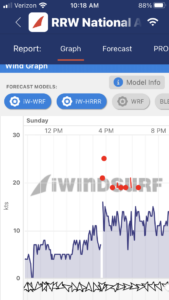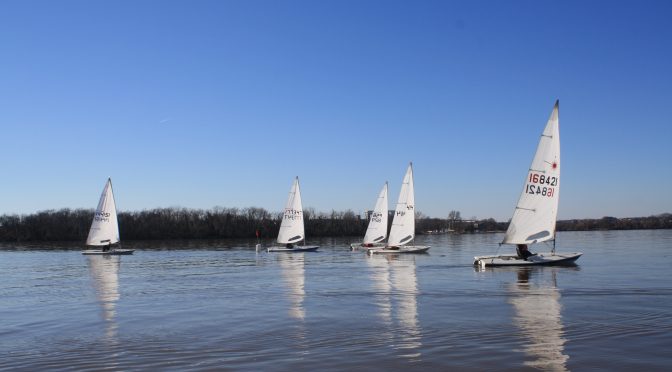Sunday was one of the best days of racing I have had this season. While light winds had been forecasted, the wind quickly increased to around ten knots with gusts well above that. It came from the south-southeast but would periodically shift farther southeast and less commonly would shift farther south. The puffs almost always came from the left side of the course. This combined with the prevailing shifts meant that the far left seemed the place to be for most of the day. While the pin was not significantly up for many of the starts, I felt that starting at the pin and taking off left was the way to go. The tide was outgoing the whole day, and so there was very significant up-course current. It took me seven seconds to travel upwind one boat length upwind at the first start while luffing.
The first start, we were in a left shift and most of the fleet was set up for the pin. I was OCS and decided to gybe and head upwind on port. I was lifted for a long time but eventually found a more average angle to tack on and head left. I rounded the weather mark in the back, but caught up to the fleet. The downwinds all day were very interesting. Because the pressure came from the left, a balance had to be struck between staying in the puffs and working to get the inside around the leeward mark. Personally, I found that by staying on the left side I could usually cleanly pass people I might have gotten tangled up with around the mark. I passed a few boats downwind, rounded the mark, and tacked immediately. I was headed for a while, but I got clear air and a very nice shift on the left side that put me in the upper half of the fleet around the top mark. The next downwind was fairly standard, I don’t remember passing anyone. The finishing leg was played very differently to the rest of the racing and overall I thought it was something I could have done better all day. It seemed like it was preferable to stay on port until on layline for the boat and then tack. I ended up finishing around fifth.
The second race went very similar. This time I accounted for the current more and was not over, but did not have a very good start. I decided to stay on starboard longer than anyone else to get clear air, and as a result overstood the layline. All day, I was right on the edge of being able to keep the boat flat in the puffs ( I am very light for the full rig). Being overstood definitely hurt more than normal because it was harder to keep the boat flat in low mode. I rounded the top mark in fifth but had a bad rounding and lost a boat right after. The downwind was very standard and I caught the boat that had passed me. All day, I thought staying more to the course left than your opponents was the only sure way to prevent them getting an excellent shift and making a comeback both upwind and downwind. By the end of the leg, I was overlapped with many boats and attempted to go wide and fall in behind the pinwheel. This did not quite go as intended and I ended up on the outside of a group. I tacked underneath and managed to gain a boat or two back on the upwind just by staying left. By now, the fleet was spread out and again I finished fifth.
The third race, I got an amazing start by winning the pin. Pretty quickly, I got headed but decided to just keep going because of good pressure up ahead. This turned out to be pretty costly and I dropped back to around third. I stayed there for the downwind but closed some distance. Rounding the top mark, I tacked on the first right shift and headed left. Shortly after, the wind began to die all over the course. It stayed a little longer on the right and it looked like some people made good gains over there. However, I could see whitecaps just before the bridge on the left and so headed that way, trusting that the wind would fill in. I have found that in general if the wind is dying and then coming back, betting on the new system rather than the old is favorable. I caught the shift perfectly as the pressure came back and ended up rounding the weather mark in first. I held this to the end of the race and took the win.
Race four, I had another great start at the pin. I found that setting up low was crucial because of the current and that there was enough wind a long runup was not essential. This was another advantage to going left upwind. Deeper water means more current so heading near the channel allowed for better speed upwind. I tacked in a much better place than race three and rounded the weather mark in first. I held on for the downwind, but going back up the wind had increased and I was struggling to keep the boat flat. I was passed by sail 603 as a result. I got close to catching him on the downwind but was unable to and followed him for the rest of the race.
Race five was very similar, I rounded the top mark in second by banging the left corner on the upwind. I was unable to catch the boat in first but managed to hold on until the last leg. Going upwind on port tack, the whole fleet was very lifted. I found a decent shift back and decided to tack sooner, mostly to cover the boats behind me. This turned out to be a mistake as I lost one boat and finished in third. I noticed someone behind me getting to the inside of a pinwheel by going very by the lee in a puff and planing for a few seconds, this seemed to work very well.
Race six, I had a good start but lost my lane quickly and was sucked back into the pack. I stayed left longer than any of the boats near me to get clear air, but two boats went further and both beat me to the weather mark along with a few others. I caught two boats downwind, but lost one back upwind because I went too far left and overstood. On the second downwind, I was sailing by the lee trying to get to a covering position when I was hit with a surprise puff and spun out into a capsize. I got to the board quickly but the sail was on the windward side so when I brought the boat up it flipped over again. I probably should have california rolled, but I had touched the bottom while righting the boat and was unsure if it was deep enough (as well as if my drysuit neck seal was good). I finished last in that race.
All told, it was a fun day on the water with near-ideal conditions that made the racing very interesting and enjoyable. If you could find a good angle on starboard tack, there were almost always opportunities to gain. While the downwind was fairly straightforward with no gybe until the end necessary, this led to great opportunities by playing for the inside and covering your opponents.
Credit to Kaitlyn for getting a good photo!
23-24 PRSA Frostbite Series #14












